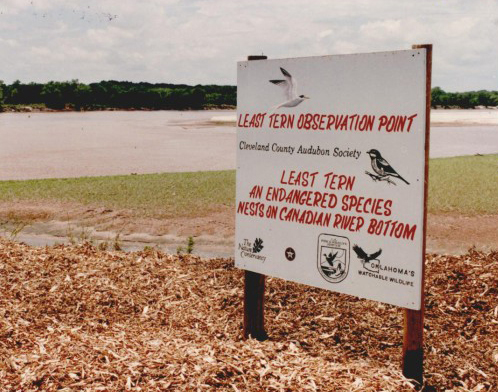
The Encyclopedia of Oklahoma History and Culture
ENDANGERED SPECIES.
By the early twentieth century Oklahoma had already lost several of its wildlife species, including the grizzly bear (Ursus arctos), gray wolf (Canis lupus), passenger pigeon (Ectopistes migratorius), Eskimo curlew (Numenius borealis), Carolina parakeet (Conuropsis carolinensis), ivory-billed woodpecker (Campephilus principalis), elk (Cervus elaphus), and American bison (Bison bison). The last two have been reintroduced to the state at refuges or ranches. By the 1970s the red wolf (Canis rufus) and black-footed ferret (Mustela nigripes) had also disappeared.
In 1973 the U.S. Congress passed the Endangered Species Act to provide for the conservation of endangered and threatened species of fish, wildlife, and plants. The law charged the secretary of the interior with determining an official list of endangered and threatened animals, devising recovery plans for various species, and implementing plans to preserve habitats and to restrict illegal trade in protected species. In 1985 the Oklahoma Legislature authorized the Oklahoma Wildlife Commission to prepare its own list of endangered and threatened species living within the state. The 1973 federal law defined "endangered" to mean species that are in danger of extinction throughout all or a significant portion of their range and defined "threatened" to include animals that are likely to become endangered within the foreseeable future.
By 1992 the federal list of Oklahoma's endangered species included the gray bat (Myotis grisescens), Indiana bat (Myotis sodalis), Ozark big-eared bat (Plecotus townsendii ingens), American peregrine falcon (Falco peregrinus anatum), Arctic peregrine falcon (Falco peregrinus tundrius), black-capped vireo (Vireo atricapilla), whooping crane (Grus americana), bald eagle (Haliaeetus leucocephalus), interior least tern (Sterna antillarum), red-cockaded woodpecker (Picoides borealis), piping plover (Charadrius melodus), Ouachita rock pocketbook (Arkansia wheeleri, a freshwater clam), winged mapleleaf (Quadrula fragosa, a mussel), and American burying beetle (Nicrophorus americanus).
The 1992 federal list of threatened species included the American alligator (Alligator mississippiensis), Neosho madtom (Noturus placidus, a flatheaded catfish), Ozark cavefish (Amblyopsis rosae), and leopard darter (Percina pantherina). The state's endangered list included all of the Oklahoma species federally designated and added the longnose darter (Percina nasuta), cave crayfish (Cambarus tartarus), and Neosho mucket (Lampsilis rafinesqueana, a freshwater mussel). To the threatened category Oklahoma also added the blackside darter (Percina maculata) and Arkansas River shiner (Notropis girardi).
Between 1992 and 2021 numerous changes, based on constant observation and evaluation, took place in the federal listings. The bald eagle was reclassified as threatened and then delisted entirely in 2007. The falcons, black-capped vireo, least tern, and American alligator were also delisted due to recovery. The scaleshell mussel (Leptodea leptodon) and Neosho mucket (Lampsilis rafinesqueana, a mussel) were placed on the endangered list, as was one plant, Harperella (Ptilimnium nodosum, mock bishops weed). The Neosho madtom and American burying beetle were downlisted from endangered to threatened status. Other additions to the federal threatened list included the Northern long-eared bat (Myotis septentrionalis), rufa red knot (Calidris canutus rufus, a migratory shorebird), rabbitsfoot (Quadrula cylindrica cylindrica, a freshwater clam), Arkansas River shiner (Notropis girardi, a minnow), and Eastern prairie-fringed orchid (Planathera leucophaea), and Western prairie fringed orchid (Platanthera praeclara). The lesser prairie chicken (Tampanuchus pallidicinctus), listed in 2014 as threatened, was delisted in 2016. In 2024 the red-cockaded woodpecker was downlisted from endangered to threatened. In addition, a number of animals are "species of special concern," which state and federal agencies watch closely and may soon be declared to be threatened.
In 1981 the state legislature passed an act that allowed Oklahomans to donate money through their state income tax form to be used in nongame wildlife management. The Oklahoma Department of Wildlife Conservation administered the programs aimed at protecting endangered species. Oklahoma penalties for hunting, harassing, or capturing the animals was a fine up to one thousand dollars and/or up to thirty days in prison. The federal government set the maximum criminal fine at fifty thousand dollars and/or one year in prison. It also provided a civil fine as high as twenty-five thousand dollars, and in 2016 the penalty increased to almost fifty thousand. In 1992 funding expired for Endangered Species Act of 1973. The law has remained in force, and Congress has continued to appropriate money. Reauthorization bills have been introduced, but none had been passed.
See Also
BIRDS, ENVIRONMENT AND CULTURAL ECOLOGY, MAMMALS, REPTILES AND AMPHIBIANS, SOIL AND WATER CONSERVATION






